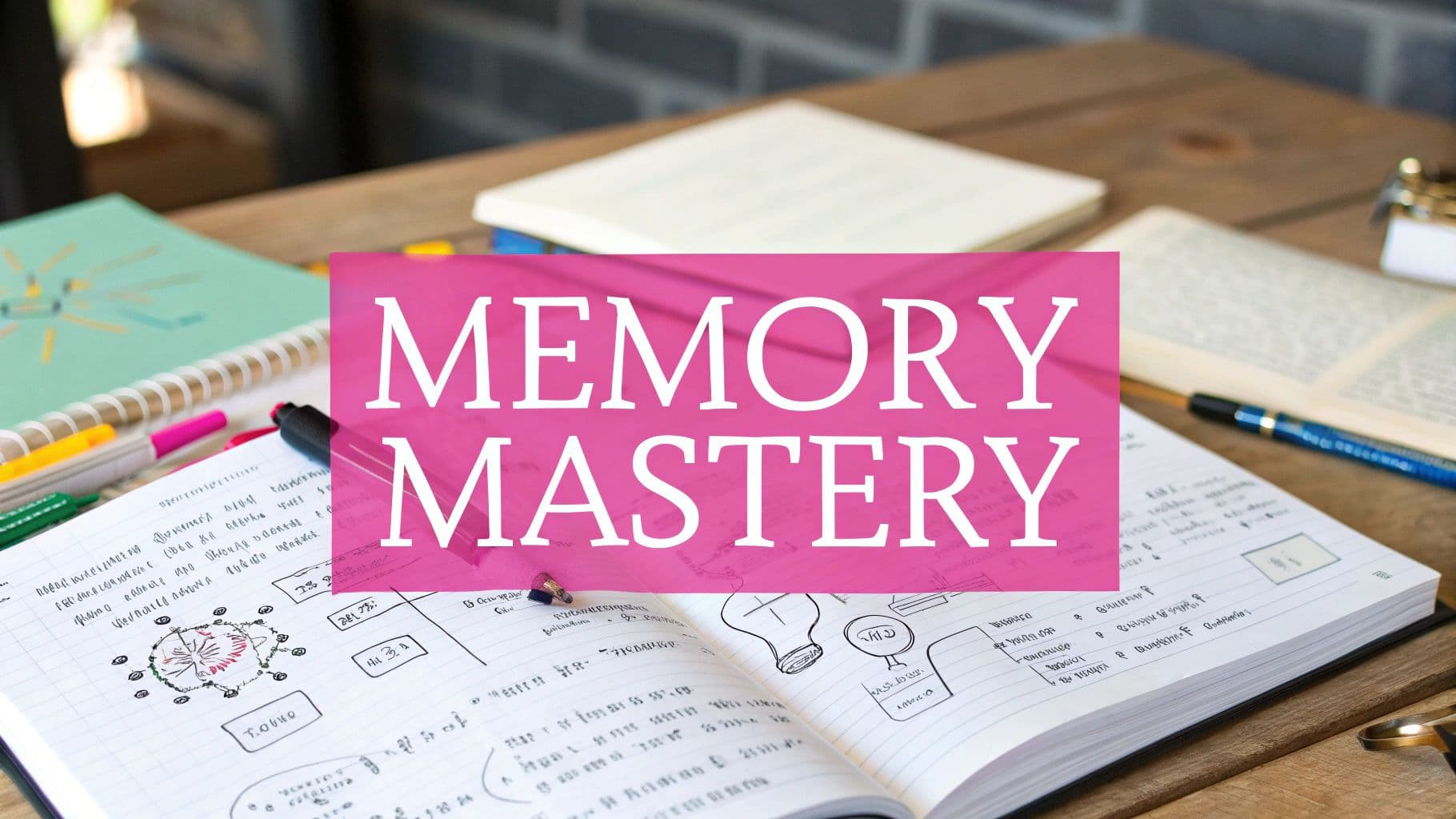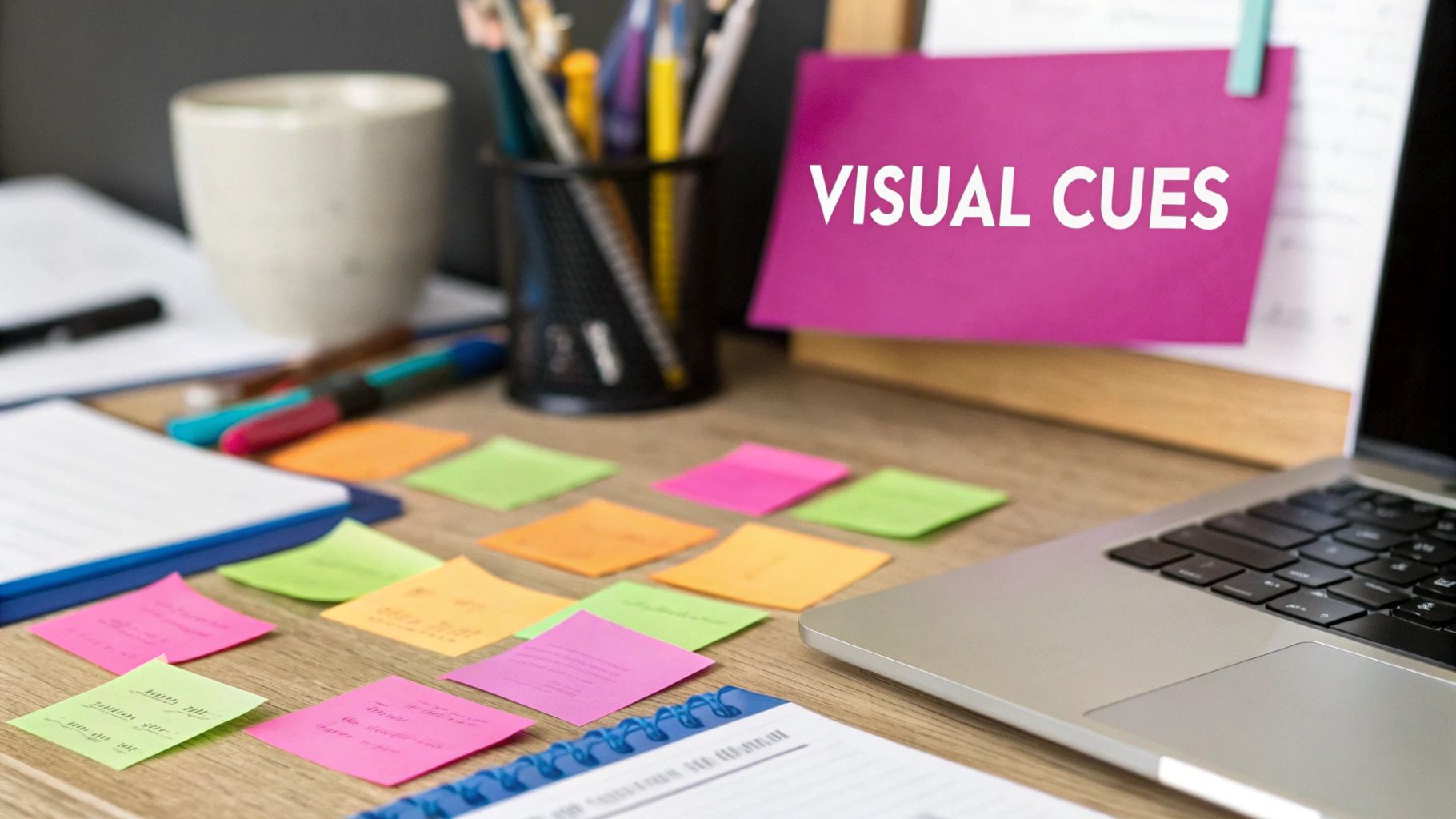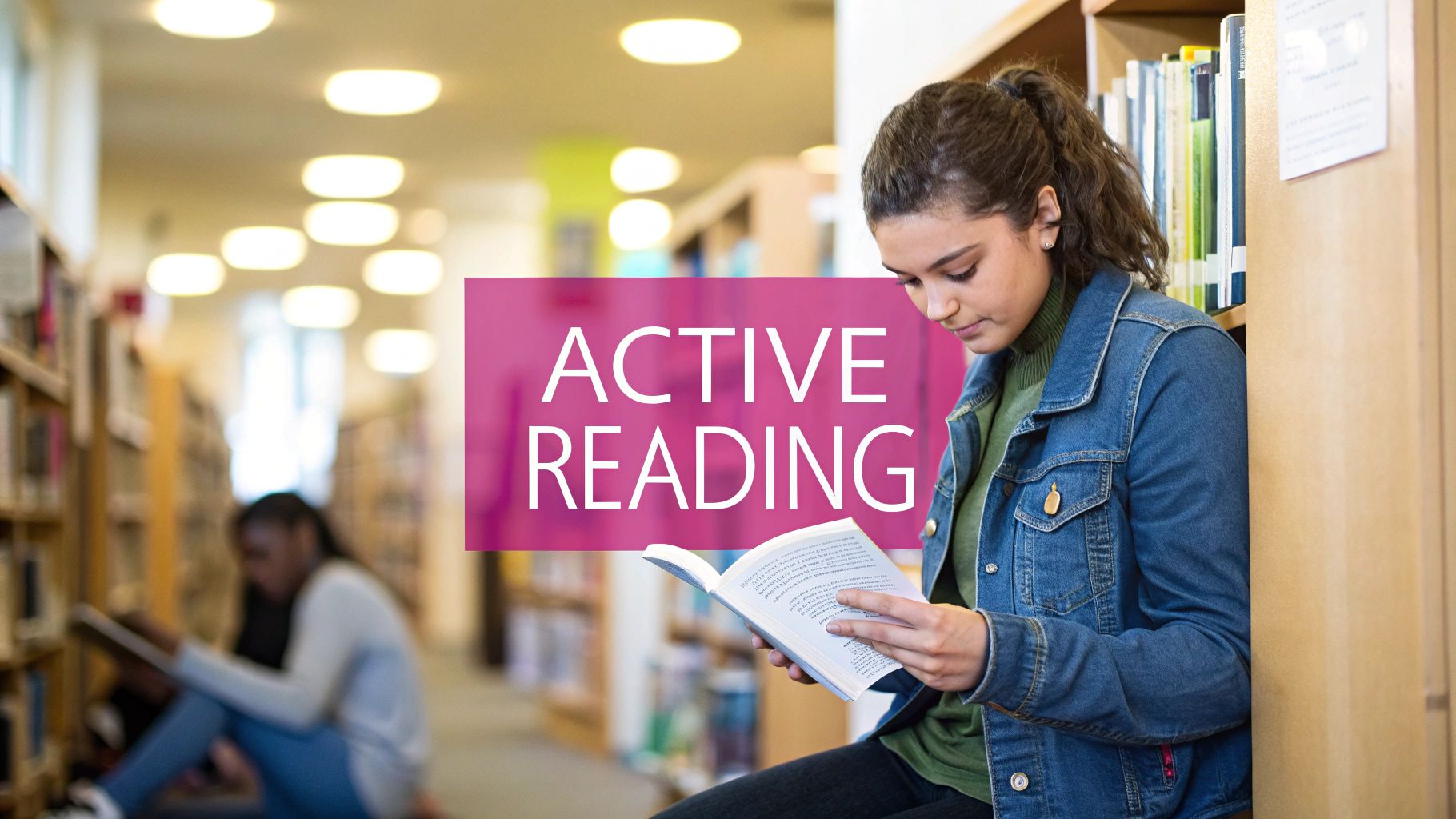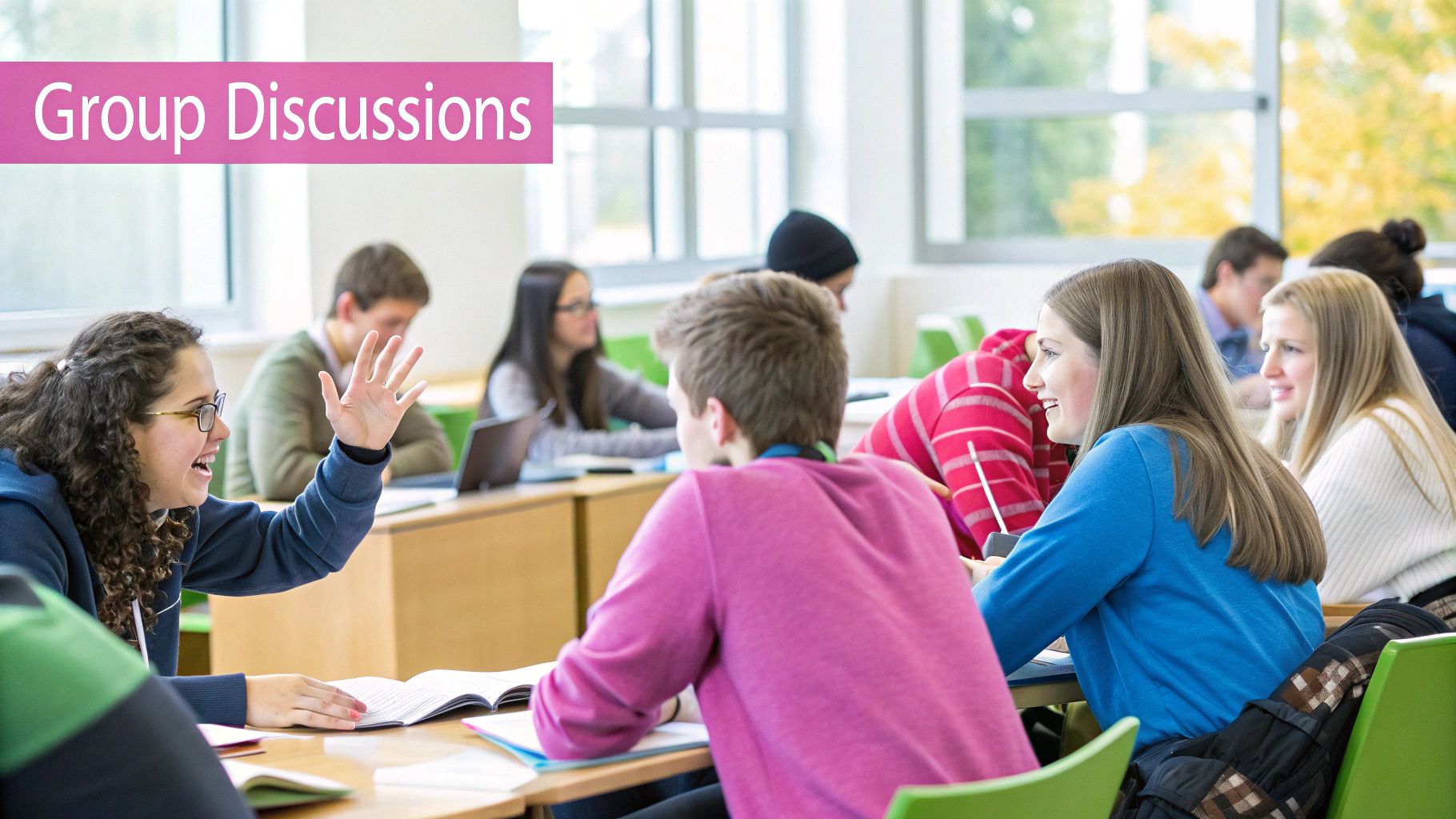
10 Best Ways to Retain Information: A Science-Backed Guide for Better Learning
The Science Behind Memory: What Experts Really Know

Learning how our brains store and access information helps us study more effectively. Rather than just memorizing random facts, understanding the actual cognitive processes gives us the tools to retain knowledge in ways that work with our natural memory systems.
How Memories Are Formed: Encoding, Storage, and Retrieval
Memory formation happens in three key stages, much like working with computer files. First comes encoding, where your brain converts sensory information into neural patterns it can process. Next is storage, where that encoded information is maintained over time. Finally, retrieval allows you to access those stored memories when needed. Each stage matters – for instance, if you're distracted during encoding, the memory won't form properly in the first place.
The Forgetting Curve: Why We Forget and How to Combat It
Our brains naturally tend to forget information over time, following what's known as the forgetting curve. Studies show we can lose up to 70% of newly learned material within just 24 hours. But don't worry – this natural process simply means we need good strategies to reinforce what we learn. The key is actively working with the information rather than trying to passively absorb it.
Active vs. Passive Learning: Engaging With Information for Better Retention
Research clearly shows that some learning methods work better than others. The Learning Pyramid demonstrates this well – passive approaches like lectures only lead to 5% retention, while reading gives about 10%. Studies confirm that people typically forget half of new information within an hour when learning passively. To really remember something, you need to engage with it actively. This could mean discussing ideas with others (50% retention), practicing real applications (75% retention), or best of all, teaching the material to someone else (90% retention). These active methods strengthen memory by making you reconstruct and work with the information multiple times.
Take learning about photosynthesis as an example. Just reading the definition probably won't stick. But if you draw out the process, explain it to a classmate, or analyze how different plants photosynthesize differently, you're much more likely to remember it long-term. This shows why methods like active recall and practical application help so much – they turn you from a passive observer into an active participant in learning, creating stronger and more accessible memories.
Teaching Others: The Ultimate Memory Hack
Learning information is one thing, but teaching it to others creates an entirely new level of understanding and retention. When you teach a concept to someone else, you must organize the information clearly, break it down into simple components, and explain it in a way that connects with your audience. This process of teaching forces your brain to process the material more deeply than just reading or reviewing it. Studies have shown that teaching others leads to an impressive 90% retention rate of information, making it one of the most powerful ways to cement knowledge in your memory.
Why Teaching Works So Well: The Protégé Effect
When you know you'll need to teach something to others, your brain automatically processes information differently. This phenomenon, known as the protégé effect, kicks in even before the actual teaching begins. You start mapping out how to explain concepts clearly, connecting new information to what you already know, and identifying the most important points to emphasize. Think about how preparing to give a presentation makes you understand a topic much more thoroughly than just sitting in the audience. The act of teaching also requires you to retrieve information from memory repeatedly, which strengthens those neural pathways each time.
Solo Teaching Strategies: Even Without an Audience
Not having someone to teach shouldn't stop you from using this powerful learning technique. You can still gain many of the benefits by teaching to an imaginary audience. Try standing up and explaining the concept out loud as if giving a lecture – this verbal practice helps organize your thoughts and reveals any gaps in your understanding. Another effective approach is the Feynman Technique, where you explain complex topics in simple terms, as if teaching a child. This process quickly shows you which parts you truly understand and which need more work. Writing out your explanation, as if creating lesson materials, can be equally valuable.
Collaborative Learning: Peer Instruction for Mutual Benefit
Studying with others creates perfect opportunities for teaching practice. By taking turns explaining different topics to each other, everyone benefits from both teaching and learning roles. This back-and-forth allows for immediate questions and clarification of confusing points. For example, in an anatomy study group, one person might teach the circulatory system while another covers the nervous system. This collaborative environment helps catch misunderstandings early and builds stronger comprehension for all participants.
Leveraging Technology: Expanding Your Teaching Toolkit
Today's digital tools open up new possibilities for teaching practice. Creating video explanations using apps like Notescast helps reinforce your understanding while creating helpful resources for others. Making these educational videos adds a visual dimension to the teaching experience and lets you contribute to the wider learning community. This approach works especially well for visual learners, as it combines clear explanations with helpful visuals. When you combine traditional teaching methods with modern tools, you create an effective system for both learning and sharing knowledge.
The Surprising Power of Handwritten Notes

Beyond teaching others, the simple act of writing notes by hand has remarkable benefits for memory and learning. When we write things down manually, we do more than just record information – we engage deeply with the material through multiple senses and mental processes. The physical motion of handwriting activates specific brain networks that typing doesn't reach, leading to better understanding and recall. This makes handwritten notes particularly valuable as part of an effective learning strategy.
The Neuroscience of Note-Taking: Why Handwriting Wins
Scientific research shows that writing by hand creates stronger neural connections related to learning and memory. A key study by Professor Kuniyoshi Sakai at the University of Tokyo found that participants taking handwritten notes showed much more activity in memory-related brain regions compared to those using devices. Their recall speed was also 25% faster. These benefits come from the rich sensory experience of handwriting – the physical sensation of pen on paper, the careful formation of letters, and seeing your thoughts take shape visually all work together to cement information in memory. For complex topics especially, handwriting helps create lasting mental imprints.
Maximizing Handwritten Notes: Strategies for Success
Getting the most from handwritten notes requires more than basic transcription. Try these proven approaches:
- Active Recall Integration: Rather than copying word-for-word, rewrite concepts in your own language and test your memory as you go. This pushes you to process information more thoroughly.
- Visual Cues and Organization: Use underlining, highlighting and symbols meaningfully to emphasize key points and show relationships between ideas. Pick an organizational method like outlining or mind mapping and stick with it consistently.
- Regular Review and Reflection: Look over your notes within 24 hours to strengthen memory formation and spot any gaps in your understanding. Add new insights and connections when you review the material.
Bridging the Gap: Handwriting in a Digital World
While most learning now happens digitally, handwriting remains uniquely valuable. The key is finding ways to combine digital resources with manual note-taking. For example, you might print digital articles to annotate by hand, or use a tablet with a stylus to write directly on electronic documents. This blended approach lets you benefit from both digital convenience and the memory-boosting power of handwriting. You can also digitize handwritten notes later for easier searching and organizing. The goal is discovering note-taking methods that work best for your learning style, with handwriting playing an important role in that mix.
Visual Learning: Transforming Information into Memory

Active learning through teaching and handwritten notes are powerful ways to retain information. But there's another highly effective method that taps into how our brains naturally process information: visual learning. Our brains can process and remember visual information much faster than text alone. By thoughtfully incorporating visuals into your study routine, you can significantly boost your ability to recall and understand new material. Let's explore specific ways to make visual learning work for you.
Why Visuals Work: Tapping Into Your Brain's Powerhouse
Our brains have an amazing capacity for processing visual information. Studies show that adding visuals and video makes information 83% easier to remember compared to text by itself. Think about how much easier it is to remember someone's face versus their name – this reflects our brain's natural talent for visual processing. When you combine text with infographics, content retention can improve by up to 65%. This makes visual learning one of the most effective ways to cement new information in your memory.
Practical Visual Techniques: From Mind Maps to Sketchnotes
You can put this visual advantage to work using several proven techniques. Mind mapping helps organize complex topics by creating visual connections between key ideas, similar to a tree with branches. This gives you both the big picture view and shows how concepts relate to each other. Sketchnotes combine basic drawings with written notes to engage multiple learning styles at once. This approach works especially well for understanding processes or relationships between ideas. The key is finding visual methods that match your learning style and the subject matter.
Combining Visuals with Other Retention Strategies
Visual learning becomes even more powerful when paired with other memory techniques. For example, creating a mind map and then explaining it to someone else combines visual organization with teaching benefits. Similarly, making sketchnotes during study time and reviewing them later reinforces learning through both visual memory and active recall. This combined approach creates stronger memory pathways, making it easier to access information when you need it. Try different combinations to find what works best for you.
Tools and Techniques for Creating Visual Aids
You don't need artistic talent to create helpful visual study materials. Simple supplies like colored pens, highlighters, and index cards let you make effective flashcards and diagrams. Many free online tools also make it easy to create professional-looking mind maps, charts, and infographics using pre-made templates. The goal isn't artistic perfection – it's making the information visually clear and memorable in a way that helps you learn. Start with basic tools and techniques, then expand as you discover what helps you learn best.
Mastering the Art of Spaced Repetition
While active recall, teaching others, and visual learning help strengthen memory, making knowledge stick for the long term requires a systematic approach to review. Spaced repetition stands out as one of the most effective techniques for information retention. This method goes beyond simple flashcard reviews by carefully timing when you revisit material for maximum impact.
Understanding the Science Behind Spaced Repetition
The key idea behind spaced repetition is reviewing information right before you would naturally forget it. When you hit this ideal timing, you strengthen the memory more effectively than if you cram or review too often. Research shows we tend to forget information quickly after first learning it – a pattern known as the forgetting curve. By spacing out reviews strategically, we work with our brain's natural memory processes to move information from short-term to long-term storage.
Creating Your Personalized Spaced Repetition System
You don't need fancy tools to use spaced repetition effectively. A basic approach uses flashcards with a consistent review schedule – check cards after one day, then three days, a week, two weeks, and so on with growing intervals. The act of retrieving the information helps cement it in memory each time. For best results, adjust the schedule based on your performance. When a card becomes easy, increase the time before reviewing it again. If you struggle with certain cards, shorten the interval. This flexibility makes the system work better for your individual learning style.
Making the Most of Spaced Repetition Tools
While physical flashcards work well, digital tools like Anki and Quizlet can enhance the process. These apps track your progress automatically and schedule reviews based on how well you know each item. They offer helpful features like multimedia cards, progress tracking, and customizable formats. Digital tools become especially valuable when working with large sets of information or subjects that need ongoing review.
Adapting Spaced Repetition for Different Learning Goals
The spaced repetition approach needs adjustment based on what you're trying to learn. For vocabulary, simple word-definition flashcards work well. More complex topics require breaking concepts into smaller chunks with cards for each piece. The key is staying engaged during reviews – explain ideas out loud, connect them to other knowledge, or think of real examples. This active engagement combined with well-timed reviews creates a strong foundation for long-term learning and recall.
Building Your Personal Retention System

Creating an effective system for retaining information requires a personalized approach that matches your unique learning style and needs. Just as everyone has different ways of processing information, your method for learning and remembering should be customized to work best for you. Let's explore how to build a system that combines proven techniques while allowing you to track and improve your results.
Combining the Best Ways to Retain Information
Think of your retention system as a collection of learning tools working together. While techniques like active recall, teaching, handwritten notes, visual learning, and spaced repetition are all effective on their own, they become even more powerful when used in combination. For example, you could draw detailed notes during a lecture, then explain those concepts to a study partner later that day – this pairs visual learning with teaching to strengthen your understanding.
To make information stick long-term, integrate spaced repetition into your routine. Review your notes at increasing intervals – first the next day, then after three days, a week, and so on. As you become more comfortable with the material, you can extend the time between reviews. This systematic approach helps move information into your long-term memory.
Tailoring Your System to Different Learning Styles and Situations
Your learning approach should adapt based on both the subject matter and your preferred learning style. For visual learners studying anatomy, creating detailed diagrams may work best. But for abstract topics like philosophy, writing summaries and having discussions could be more helpful.
Your system also needs flexibility for different learning environments. In a classroom, quick handwritten notes might make the most sense. When studying independently, you can use tools like Notescast to create video explanations and digital study aids.
Tracking Your Progress and Making Adjustments
Monitoring your results is essential for improving your system over time. Pay attention to which techniques help you recall information best. If you notice you're struggling to remember material during reviews, you may need to adjust your approach – perhaps reviewing more frequently or trying new study methods.
Regular evaluation helps optimize your system. Ask yourself: Are you meeting your learning goals? Can you recall information weeks or months later? Use these insights to refine your approach and make it more effective.
Examples of Personalized Retention Systems
| Learning Goal | Subject | Techniques Used | Tracking Method |
|---|---|---|---|
| Master Anatomy | Human Circulatory System | Visual diagrams, flashcards, teaching a study partner | Quizzing self, explaining concepts to others |
| Understand Philosophical Concepts | Existentialism | Reading summaries, writing reflective essays, group discussions | Journaling insights, participating in online forums |
| Learn a New Language | Spanish | Vocabulary flashcards, language learning apps, conversation practice | Tracking vocabulary acquisition, fluency in conversation |
Creating your personal retention system is an ongoing process of testing different methods and observing what works best for you. By staying consistent with your chosen techniques while remaining open to adjustments, you'll develop an approach that helps you learn and remember information effectively.
Want to enhance your learning experience? Notescast helps you create engaging video summaries of your notes and study materials. Visit Notescast today to discover how visual learning can improve your retention.
